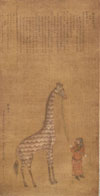Ming
(1368-1644)
The Chinese people rallied behind a peasant named Chu Yüan-chang, and together they overthrew Mongol rule. In 1368 Chu took the imperial name Hung-wu and called his dynasty the Ming. In a thirty year reign he brooked no dissent, and any hint of corruption or disloyalty was swiftly crushed. His purges resulted in the execution of some sixty thousand unfortunates. Cabinet rule was abandoned, and Emperor Hung-wu controlled all matters of state.
Purging would be the model followed by many of Ming’s emperors upon coming to the throne. Some emperors found the task of total state control too burdensome and yielded day-to-day responsibilities to eunuchs, who would come to number in the tens of thousands. Emperor Yung-lo, in the first decades of the fifteenth century, even established eunuchs as spies. Buried within the military and civil offices, they had full authority to root out corruption, which they did through torture and death.

Zheng He
and Giraffe
c. 1414
Yongle Period
scroll
31 1/2 x 16 in.
Courtesy Philadeplphia Museum of Art
Emperor Cheng-t’ung led a major offensive northward against the Mongols, who continued to trouble China’s borders. One disastrous decision followed another until the Mongol rout of the Chinese army was complete, and the Emperor was led away a captive. Yet for all the troubles wrought by eunuchs, one, Admiral Cheng Ho, led China’s greatest maritime expedition. Between 1405 and 1421 Admiral Cheng sailed a great fleet on six voyages ranging as far west as eastern Africa and into the Persian Gulf, collecting scientific specimens, cartographic knowledge, and showing China’s flag to new lands. He sailed, in part, to find tributary states to help fill government coffers as the Ming government was strapped for cash even though its domestic economy thrived.
Through the dynasty’s last four emperors and its last forty years, China was unable to control its economy or its borders. The Manchus, a vassal state to China’s north, began violating its territory, winning several brilliant victories. At the same time inflation ravaged the currency, and floods, droughts, plagues, and starvation did likewise to China’s people. In 1644, by the time Ming’s last emperor hanged himself, the exhausted dynasty had reached its end.